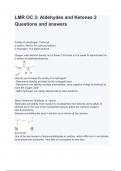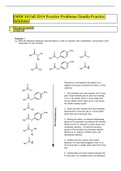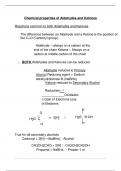Nucleophiles Study guides, Class notes & Summaries
Looking for the best study guides, study notes and summaries about Nucleophiles? On this page you'll find 134 study documents about Nucleophiles.
Page 4 out of 134 results
Sort by

-
CHM 219 MODULE 4 EXAM | QUESTIONS & ANSWERS (VERIFIED) | LATEST UPDATE | GRADED A+
- Exam (elaborations) • 8 pages • 2024
-
- $10.99
- + learn more
1 CHM 219 MODULE 4 EXAM | QUESTIONS & ANSWERS (VERIFIED) | LATEST UPDATE | GRADED A+ Organohalides Correct Answer: Organic molecules contains Halogen atoms. Ex. Algae, Mollusk, sponges, can be industrially used - solvents, insecticides, herbicides, cleaning fluids, fire retardants, refrigerants. Can also be used as inhaled anesthetic. More important in organic chemistry because of theur reactivity. Two of the most important reaction types typical of organic Halides are.... Corr...

-
MCAT Official Prep Chemistry Question Pack ALL SOLUTION 100% CORECT AID GRADE A+
- Exam (elaborations) • 8 pages • 2024
-
- $11.19
- + learn more
Question 2: If an archaebacterial species lives in a pool that is 0.01 M HCl(aq), what is the pH of the water? A. 12 B. 6 C. 2 D. 0.01 Correct answer: C The pH of a solution is defined as -log[H+] Since HCL completely dissociates in water, the concentration of HCl is equal to the concentration of H+ Question 9: If a leak develops in the vacuum distillation apparatus, the boiling points of the two components of caraway seed oil will: A. both increase. B. both decrease. C. both re...

-
Chem 210 Exam II with complete solutions already graded A+
- Exam (elaborations) • 6 pages • 2023
- Available in package deal
-
- $13.99
- + learn more
electrophiles electron seeking reagents that have room to accept a electron pair nucleophiles reagents seeking a nucleus to which to donate a pair of electrons proton transfer or protonation reaction the transfer of a proton from one base to another transition state lying between the products and reactants free energy of activation (delta G double dagger) the height of the barrier, the energy that the reactants attain in reaching the the transition state e...

-
Organic Chemistry 6Th Edition By Smith
- Exam (elaborations) • 61 pages • 2023
-
- $30.79
- + learn more
Organic Chemistry 6Th Edition By Smith – Test Bank Sample Questions Instant Download With Answers Chapter 3 Introduction to Organic Molecules and Functional Groups 1) Which of the following lists contains common heteroatoms found in organic molecules? 1. A) N, O, S, P, Cl 2. B) Na, O, S, P, Cl 3. C) Na, Mg, S, N, Cl 4. D) Na, Mg, O, N, Cl Answer: A Difficulty: 1 Easy Section: 03.01 Topic: Functional Groups Bloom’s: 2. Understand Chapter: 03 Accessibility: Keyboard Na...

-
LMR OC 3: Aldehydes and Ketones 2 Questions and answers
- Exam (elaborations) • 3 pages • 2024
- Available in package deal
-
- $7.99
- + learn more
Acidity of α-Hydrogen: Carbonyl α-carbon: Next to the carbonyl carbon. α-Hydrogen: H of alpha carbons Oxygen pulls electron density out of these C-H bonds so it's easier to deprotonate the α-carbon of aldehydes/ketones. How do you increase the acidity of α-Hydrogen? - Resonance stability provided by the conjugate base - Resonance can stabilize enolate intermediate, since negative charge is distributd to more EN oxygen atom - Alpha hydrogen can easily deprotonate in basic solutions...

-
AQA A Level Chemistry 2022 Paper 2 SOLUTION 2023//2024
- Exam (elaborations) • 5 pages • 2023
-
- $9.99
- + learn more
How can we make polymers more flexible? - ANSWER By adding a plasticiser How do plasticisers make polymers more flexible? - ANSWER They stick between the chains and keep the polymers further apart from each other, weakening the van der Waals forces and lets chains slide more easily. Uses of Kevlar - ANSWER bulletproof and used in body armour. Uses of Nylon - ANSWER commonly used in textiles. Why are polymers strong? - ANSWER Polymers are bound by van der Waals forces. The intermolecula...

-
Chem 210 Exam 3 Questions and Correct Answers, With Complete Solution
- Exam (elaborations) • 8 pages • 2024
-
- $10.49
- + learn more
Chem 210 Exam 3 Questions and Correct Answers, With Complete Solution. what face of the pi bond can EAR occur from? either face how many products do EARs on an alkene form? 4 stereoisomeric products Brainpower Read More in a substitution rxn, what does H-O act as? nucleophile and replaces LG in an elimination rxn, what does H-O acts as? base and abstracts BH atom what is a requirement for elimination rxns? beta hydrogen what is a requirement for substitution rxns? leaving group ...

-
CHEM 30 Fall 2014 Practice Problems Claudia Practice Solutions • Harvard University • CHEM 30
- Exam (elaborations) • 8 pages • 2022
-
- $7.99
- + learn more
Question 1 (a) Rank the following carboxylic acid derivatives in order of reactivity with nucleophiles, and provide a brief explanation for your ranking. O Me Me N Me O O Me O O NO2 OMe O Me Cl O Me OEt Me O Me O Me Cl O Me O O Me OEt O Me O O Me Me N Me O Me NO2 OMe Reactivity is correlated to the ability of an adjacent lone pair to donate into the *CO of the carbonyl. 1. Acid chlorides are most reactive: the Cl lone pair is least donating due to poor size o...

-
Chem 210 Exam 3 Questions with Correct Solutions| Rated A+
- Exam (elaborations) • 9 pages • 2023
- Available in package deal
-
- $10.99
- + learn more
what factors explain the outcomes of reactions? - hybridization, delocalization, eN, atom density what is a leaving group? - - group of atom(s) that can be stable on its own - eN atoms that are good LG also make strong acids what is the α carbon? - C directly attached to leaving group what are β Cs? β Hs? - βC: C(s) attached to α carbon βH: H(s) attached to βC what is a LB? is it a nucleophile or electrophile? - lewis base, nucleophile what is nucleophilic ...

-
Chemical properties of Aldehydes and Ketones Reactions common to both Aldehydes and Ketones The difference between an Aldehyde and a Ketone is the position of the C=O (Carbonyl group). Aldehyde – always on a carbon at the end of the chain Ketone – Always
- Exam (elaborations) • 83 pages • 2024
-
- $15.99
- + learn more
Chemical properties of Aldehydes and Ketones Reactions common to both Aldehydes and Ketones The difference between an Aldehyde and a Ketone is the position of the C=O (Carbonyl group). Aldehyde – always on a carbon at the end of the chain Ketone – Always on a carbon at middle carbon of the chain 1. BOTH Aldehydes and Ketones can be reduced Aldehyde reduced to Primary Alcohol Reducing agent = Sodium tetrahydroborate III (NaBH4) Ketone reduced to Secondary Alcohol Reduction Oxid...

Do you wonder why so many students wear nice clothes, have money to spare and enjoy tons of free time? Well, they sell on Stuvia! Imagine your study notes being downloaded a dozen times for $15 each. Every. Single. Day. Discover all about earning on Stuvia


